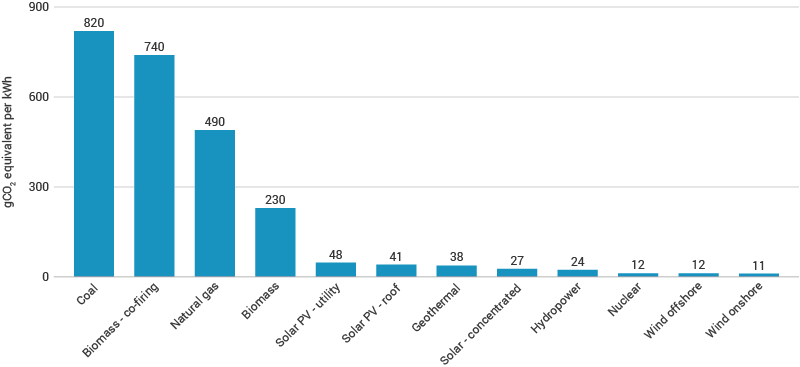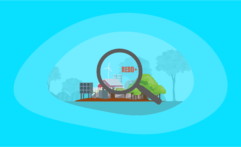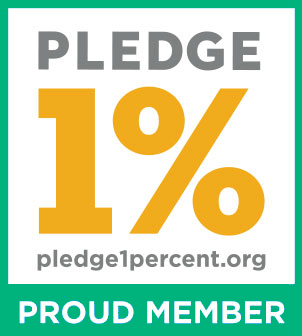Wind Energy Explained: All You Need to Know
Affiliate Disclosure
Hey fellow impactful ninja ?
You may have noticed that Impactful Ninja is all about providing helpful information to make a positive impact on the world and society. And that we love to link back to where we found all the information for each of our posts.
Most of these links are informational-based for you to check out their primary sources with one click.
But some of these links are so-called "affiliate links" to products that we recommend.
Why do we add these product links?
First and foremost, because we believe that they add value to you. For example, when we wrote a post about the environmental impact of long showers, we came across an EPA recommendation to use WaterSense showerheads. So we linked to where you can find them. Or, for many of our posts, we also link to our favorite books on that topic so that you can get a much more holistic overview than one single blog post could provide.
And when there is an affiliate program for these products, we sign up for it. For example, as Amazon Associates, we earn from qualifying purchases.
What do these affiliate links mean for you?
First, and most importantly, we still only recommend products that we believe add value for you.
When you buy something through one of our affiliate links, we may earn a small commission - but at no additional costs to you.
And when you buy something through a link that is not an affiliate link, we won’t receive any commission but we’ll still be happy to have helped you.
What do these affiliate links mean for us?
When we find products that we believe add value to you and the seller has an affiliate program, we sign up for it.
When you buy something through one of our affiliate links, we may earn a small commission (at no extra costs to you).
And at this point in time, all money is reinvested in sharing the most helpful content with you. This includes all operating costs for running this site and the content creation itself.
What does this mean for me personally?
You may have noticed by the way Impactful Ninja is operated that money is not the driving factor behind it. It is a passion project of mine and I love to share helpful information with you to make a positive impact on the world and society. However, it's a project in that I invest a lot of time and also quite some money.
Eventually, my dream is to one day turn this passion project into my full-time job and provide even more helpful information. But that's still a long time to go.
Stay impactful,
Wind is an abundant and powerful natural resource that can act as a low carbon emissions source of energy. So, we had to ask: What is wind energy really, and how can it help to mitigate climate change?
Wind energy is the conversion of moving air into energy via wind turbines. Per KWh produced, onshore wind emits 11 and offshore wind emits 12 grams of CO2 on a life-cycle basis. Wind energy helps combat climate change and has various additional environmental benefits.
Keep reading to find out all about what wind energy is, its global capacity, its carbon footprint, its environmental benefits and drawbacks, and how it can contribute to climate change.
The Big Picture of Wind Energy
Wind energy contributes to the avoidance of greenhouse gas (GHG) emissions from the burning of fossil fuels (e.g., coal, oil, natural gas). It is classified as a renewable energy source because the resource (wind) naturally replaces itself over time.
How Is Wind Energy Defined
Wind energy is defined as the conversion of moving air into electrical energy through the use of wind turbines.
“Wind: a current of air moving approximately horizontally, especially one strong enough to be felt”
Cambridge Dictionary
Wind energy makes up an ever-growing amount of total energy consumption and has various environmental implications.
What Are the Different Types of Wind Energy
Harnessing wind energy falls into two main categories:
- Onshore wind energy: Wind turbines are located on land. Construction, transportation, maintenance costs, and infrastructure needed to transmit electricity from onshore turbines to consumers are low.
- Offshore wind energy: Wind turbines are located in the ocean or freshwater. Construction, transportation, maintenance costs, and infrastructure needed to transmit electricity from offshore turbines to consumers are high.
Onshore wind is the main mechanism used today to harness wind energy. An average annual wind speed of 9 miles per hour (mph) for small turbines and 13mph for utility-scale turbines is necessary to economically harness wind energy.
There are also two types of wind turbines:
- Horizontal Axis Wind Turbine (HAWT): Blades are assembled on a horizontal axis parallel to the ground. They can only receive and process wind head-on.
- Vertical Axis Wind Turbine (VAWT): Blades are assembled on a vertical axis perpendicular to the ground. They can receive and process wind from all directions, giving them a greater energy generation potential.
Lastly, wind turbines can be divided into three categories based on how much power they are capable of generating:
- Small (individual) turbines: Can produce up to 100 kilowatts (kW) of power, which is enough to power a home or a water pumping station.
- Large turbines: Consist of 260-foot (80 meter (m)) tall towers and 130-foot (40m) long blades that can generate up to 1.8 megawatts (MW) of power.
- Commercial turbines: Consist of 780-foot (240 m) tall towers and 530-foot (162 m) long blades that can generate anywhere from 4.8 to 9.5 MW of power.
Wind energy encompasses a diverse range of materials, technologies, and environmental implications. So let’s have a closer look at these next.
| What wind energy is | Wind energy is defined as the conversion of moving air into electrical energy through the use of wind turbines. |
| What the different types wind energy are | The two types of wind energy are onshore and onshore wind energy. Wind turbines can be classified based on orientation (horizontal or vertical) and amount of power produced (small, large, commercial). |
| How wind energy works | Wind energy works by harnessing the energy of moving air, which turns turbines and spins generators to produce electricity. |
| The global capacity of wind energy | Wind energy accounts for roughly 26% of all renewable energy generation. China, the United States, Germany, India, and Spain are the largest wind energy-producing countries in the world. |
| The carbon footprint of wind energy | On a life-cycle basis, onshore wind energy emits 11 and offshore wind energy emits 12 grams of CO2 equivalent per kWh of electricity produced. |
| The environmental benefits of wind energy | Wind energy is a renewable and sustainable energy source that has a low carbon footprint, protects air quality, and generates very few waste products. |
| The environmental drawbacks of wind energy | Wind energy is an intermittent energy source, can cause noise and visual pollution, and can negatively impact wildlife if proper siting, construction, and disposal methods are not followed. |
| Wind energy and climate change | Wind energy combats climate change by mitigating the temperature rise, sea-level rise, ice melting, and ocean acidification associated with global warming. |
How Does Wind Energy Work
To harness wind energy, the wind turns the turbine blades around a rotor, which spins a generator to create electricity.
How Does Wind Energy Actually Produce Energy
Individual wind turbines use aerodynamic force from rotor blades to turn kinetic energy into electricity. Clusters of turbines (wind farms) work together to generate large quantities of electricity.
Wind energy operates in the following manner:
- Wind flows across a turbine blade, creating a difference in air pressure across the two sides of the blade
- The blade spins in response, thereby spinning the rotor
- Spinning the rotor powers a generator which creates electricity
An average annual wind speed of 9 miles per hour (mph) or 4 meters per second (m/s) for small turbines and 13mph (5.8m/s) for utility-scale turbines is necessary to economically harness wind energy.
What Is the Global Capacity of Wind Energy
Globally, wind energy is one of our fastest-growing renewable energy sources, accounting for roughly 26% of all renewable energy generation in 2023.

Wind energy produced over 2,300 TWh of electricity in 2023, which was second only to hydropower. Currently, China leads the world in wind power generation (885 TWh) followed by the US (425 TWh), Germany (137 TWh), Brazil (95 TWh), and the United Kingdom (82 TWh).

The global installed capacity of wind energy increased by a factor of 75 between 1997 and 2018, increasing from 7.5 GW to over 564 GW. Since 2018, installed capacity has almost doubled to reach a high of 1,017 GW.
The International Energy Agency (IEA) has labeled wind energy as “more efforts needed” in their Net Zero by 2050 scenario. The scenario envisions 7,400 TWh of wind energy in 2030, which would require an average expansion of approximately 17% per year during 2023-2030. Although policy support has increased in major markets such as China and the US, further efforts are needed to meet these ambitious targets.
Because wind energy is one of the fastest-growing renewable energy technologies with a low carbon emissions profile, it is important to understand what its carbon footprint is and how its carbon emissions affect the global climate change process.
What Is the Carbon Footprint of Wind Energy
The carbon footprint is one of the ways we measure the effects of human-induced global climate change. It primarily focuses on the greenhouse gas (GHG) emissions associated with consumption and includes other emissions such as methane (CH4), nitrous oxide, and chlorofluorocarbons (CFCs).
“Carbon footprint: the amount of greenhouse gasses and specifically carbon dioxide emitted by something (such as a person’s activities or a product’s manufacture and transport) during a given period”
Merriam Webster
Basically, it is the amount of carbon emitted by an activity or an organization. This includes GHG emissions from fuel that we burn directly (e.g., heating a home, driving a car) and GHG emissions from manufacturing the products that we use (e.g., power plants, factories, and landfills).
On a life-cycle basis, onshore wind energy emits 11 grams and offshore wind energy emits 12 grams of CO2 equivalent per kWh of electricity produced, the joint-lowest out of all fuel types.

When discussing the carbon footprint of wind energy, we must take into account carbon emissions across the energy’s building, operating, and building back phases.
| The life-cycle stages of wind energy | Each stage’s carbon footprint |
| Building of wind energy | CO2 emissions from the construction of wind power plants and electricity delivery mechanism |
| Operating of wind energy | Little to no CO2 emissions or waste products |
| Building back of wind energy | CO2 emissions from decommissioning the wind turbines and land restoration |
Wind energy produces 0.02% of the CO2 emissions per unit of electricity than coal produces. And after 3 to 6 months of operation, a wind turbine has effectively offset all emissions from its construction, which means it can operate virtually carbon-free for the rest of its lifetime.
Because wind energy makes up an increasingly larger portion of renewable energy generation worldwide, it is important to understand what its carbon footprint is and how its carbon emissions affect the global climate change process.
How Environmentally Friendly Is Wind Energy
The environmental impacts of wind energy largely depend on where wind farms are constructed.
“Environmentally friendly: (of products) not harming the environment.”
Cambridge Dictionary
Overall, wind energy is sustainable because it does not emit greenhouse gasses, and land use, wildlife impact, and public health concerns can be mitigated by proper planning and siting of wind farms.
What Are Environmental Benefits of Wind Energy
Wind energy is a renewable and sustainable energy source that has a low carbon footprint, protects air quality, and generates very few waste products.
| 4 Environmental Benefits of Wind Energy | Quick Facts |
| Benefit #1: Wind energy is a renewable and sustainable energy source | Wind energy is a renewable and sustainable resource that can reduce emissions for generations to come. |
| Benefit #2: Wind energy has a low carbon footprint | Wind energy has one of the lowest carbon footprints out of all energy types. On a life-cycle basis, onshore wind energy emits 11 and offshore wind energy emits 12 grams of CO2 equivalent per kWh of electricity produced, the joint-lowest out of all fuel types. |
| Benefit #3: Wind energy protects air quality | Wind energy produces a fraction of the pollution and toxic chemicals that fossil fuels produce, helping to protect air quality. |
| Benefit #4: Wind energy generates few waste products | Wind energy generates few waste products upon operation, and some components of wind energy can be recycled. |
What Are Environmental Drawbacks of Wind Energy
Wind energy is an intermittent energy source, can cause noise and visual pollution, and can negatively impact wildlife if proper siting, construction, and disposal methods are not followed.
| Drawback #1: Wind energy is an intermittent energy source | Wind energy production is heavily influenced by location, time of year, and weather patterns, making it unpredictable at times. |
| Drawback #2: Wind energy can cause noise and visual pollution | The mechanical operation and large nature of wind turbines can generate noise and visual pollution. |
| Drawback #3: Wind energy can negatively impact wildlife | During wind energy site construction, the increased presence of people, traffic, and noises can disrupt grouse and other ground-nesting birds. In addition, spinning turbine blades can prove to be a hazard for birds and bats. |
What Role Does Wind Energy Play in Combating Climate Change
Climate change is arguably the most severe, long-term, global impact of fossil fuel combustion. Every year, approximately 33 bt of CO2 are emitted from burning fossil fuels. The carbon found in fossil fuels reacts with oxygen in the air to produce CO2. This warms the earth by acting as a heating blanket, and a warmer earth comes with a host of negative side effects.
Using wind energy instead of fossil fuel energy helps mitigate the following negative effects of climate change:
- Increasing temperatures: Earth’s atmosphere has warmed 1.5℃ since 1880. This may not seem like a lot, but these degrees create regional and seasonal temperature extremes, reduce sea ice, intensify rainfall and drought severity, and change habitat ranges for plants and animals.
- Rising sea levels: Global sea levels have increased approximately 8-9 inches since 1880, displacing people living along coastlines and destroying coastal habitats. Roads, bridges, subways, water supplies, oil and gas wells, power plants, sewage treatment plants, and landfills remain at risk if sea level rise goes unchecked.
- Melting of sea ice: Since 1979, arctic sea ice has declined by 30%. Sea ice plays a major role in regulating the earth’s climate by reflecting sunlight into space and providing habitat for animal species. If all of the glaciers on Earth melted, sea levels would rise by approximately 70 feet, effectively flooding out every coastal city on the planet.
- Changing precipitation patterns: Extreme weather events (e.g., hurricanes, floods, droughts) are becoming more common and more intense. Storm-affected areas will experience increased precipitation and flooding whereas areas located further from storm tracks will experience decreased precipitation and droughts.
- Ocean acidification: The ocean absorbs 30% of the CO2 released into the atmosphere, which decreases the pH (increases the acidity) of the ocean. In the past 200 years, the pH of oceans has decreased by 0.1 pH units, which translates to a 30% increase in acidity. Aquatic life unable to adjust to this rapid acidification will die off. A prime example of this is coral bleaching, where coral expel the algae (zooxanthellae) living in their tissues as a result of changes in temperature, light, or nutrients.
The more we reduce CO2 emissions, the more we slow the rate of temperature rise, sea-level rise, ice melting, and ocean acidification. When these rates are slowed, the earth’s biodiversity does not have to struggle to adapt to temperature and pH changes. People will not be displaced due to the flooding of coastal areas. And icebergs will continue to provide climate regulation.
To help keep global temperature rise below 1.5C, as outlined in the Paris Agreement, we must shift at least 80% of our electricity generation to low carbon sources. Over 120 countries have already stated their net-zero carbon emissions ambitions for 2050 or 2060. But only 12 countries have thus far proposed or enacted any legislation, indicating that there is more work to be done.
Final Thoughts
Wind energy currently makes up nearly a quarter of all renewable energy generation. Via wind turbines, moving air turns turbines and spins generators to produce electricity. If properly maintained, wind turbines can last 20 years and provide a low carbon emissions source of energy.
Wind energy is an environmentally friendly energy source with a low carbon footprint across its building, operating, and building back phases. It produces the lowest CO2 emissions out of all energy types while creating jobs and promoting energy independence. Environmental concerns such as wildlife impact, land use, and noise pollution can all be mitigated by proper siting of wind farms. As we look towards a future powered by renewables, wind energy is a sustainable energy source that benefits both our atmosphere and Earth’s biota.
Stay impactful,

Sources
- Impactful Ninja: Renewable Energy Explained: All You Need to Know
- Impactful Ninja: Fossil Fuel Energy Explained: All You Need to Know
- Impactful Ninja: Coal Energy Explained: All You Need to Know
- Impactful Ninja: Oil Energy Explained: All You Need to Know
- Impactful Ninja: Natural Gas Energy Explained: All You Need to Know
- US Department of Energy: How Do Wind Turbines Work?
- National Geographic: Wind Power Information and Facts
- National Grid Group: Onshore vs offshore wind energy: what’s the difference?
- US Energy Information Administration: Where wind power is harnessed
- Conserve Energy Future: The Comparison of Horizontal and Vertical Axis Wind Turbines
- US Energy Information Administration: Where wind power is harnessed
- Our World in Data: Renewable Energy
- Our World in Data: Renewable energy generation, World
- Our World in Data: Wind power generation
- International Renewable Energy Agency: Wind energy
- International Energy Agency: Wind
- Britannica: Carbon Footprint
- United States Environmental Protection Agency: System of Registries
- World Nuclear Association: Carbon Dioxide Emissions from Electricity
- Impactful Ninja: What Is the Carbon Footprint of Wind Energy? A Life-Cycle Assessment
- How Environmentally Friendly Is Wind Energy? A Life-Cycle Analysis | Impactful Ninja
- Impactful Ninja: Renewable Energy Explained: All You Need to Know
- Impactful Ninja: Sustainable Energy Explained: All You Need to Know
- US Energy Information Administration: Wind energy and the environment
- National Grid Group: Can wind turbine blades be recycled?
- Impactful Ninja: The 4 Main Environmental Benefits of Wind Energy: The Big Picture
- US Fish & Wildlife Service: Wind Energy
- US Department of Energy: WINDExchange – Wind Turbine Sound
- Impactful Ninja: The 3 Main Environmental Drawbacks of Wind Energy: The Big Picture
- The National Wildlife Federation: Climate Change
- National Oceanic and Atmospheric Administration: Climate Change – Global Temperature
- National Oceanic and Atmospheric Administration: Climate Change – Global Sea Level
- United States Geological Survey: How would sea level change if all glaciers melted?
- National Aeronautics and Space Administration, USA: How does climate change affect precipitation?
- National Oceanic and Atmospheric Administration: Ocean Acidification
- National Ocean Service: What is coral bleaching?
- United Nations Framework Convention on Climate Change: The Paris Agreement
- International Energy Agency: Oil 2021







